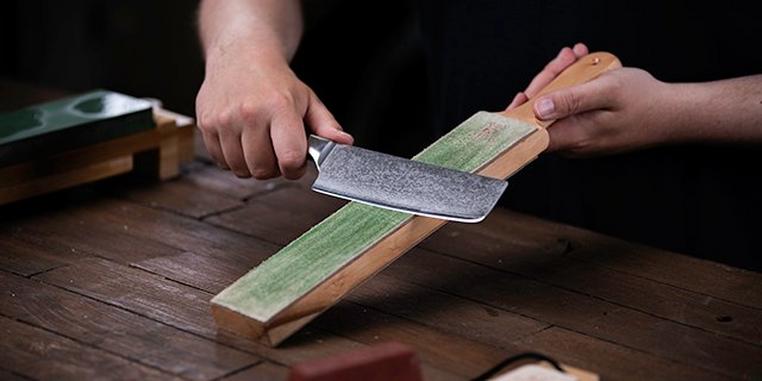What is stropping?
Polishing the edge of a sharp knife is called stropping. Usually this is done on a leather strap, mostly applied to a hard surface.
Stropping removes the last imperfections of the cut. With even greater sharpness as a result. It also has an aesthetic goal: stropping makes the cut shine like a mirror. This is also called “mirror-edge”. It is a technique that many people associate with classic razors, but also outdoor knives, pocket knives and kitchen knives benefit from stropping.
The polishing is enhanced by using a compound, paste or emulsion. This is applied to the strop, paddle, or on another surface such as balsa wood or even a piece of newsprint.
Stropping really works!
It is perhaps difficult to imagine, but by sharpening a knife with a leather strop, the cut will be significantly sharper. A requirement is that you have sharpened the knife in advance. When talking about Japanese whetstones, we recommend to sharpen until at least 5000 grain before starting with stropping. Depending on the steel grade and the hardness of the blade, you will notice an improvement pretty soon when starting stropping. When you are testing a non-stropped knife by cutting a piece of paper, you will often notice that the knife catches and tears the paper. This also occurs with knives that are already sharpened. When you strop such a knife, you will notice that the tearing will be replaced with a smooth slice. Strops can be, in certain cases, even a better choice than a grinding stone with a finer grain.

?%24center=center&%24poi=poi&%24product-image%24=&fmt=auto&h=500&poi=%7B%24this.metadata.pointOfInterest.x%7D%2C%7B%24this.metadata.pointOfInterest.y%7D%2C%7B%24this.metadata.pointOfInterest.w%7D%2C%7B%24this.metadata.pointOfInterest.h%7D&scaleFit=%7B%28%24this.metadata.pointOfInterest%29%3F%24poi%3A%24center%7D&sm=c&w=1208)
?%24center=center&%24poi=poi&%24product-image%24=&fmt=auto&h=500&poi=%7B%24this.metadata.pointOfInterest.x%7D%2C%7B%24this.metadata.pointOfInterest.y%7D%2C%7B%24this.metadata.pointOfInterest.w%7D%2C%7B%24this.metadata.pointOfInterest.h%7D&scaleFit=%7B%28%24this.metadata.pointOfInterest%29%3F%24poi%3A%24center%7D&sm=c&w=1208)





